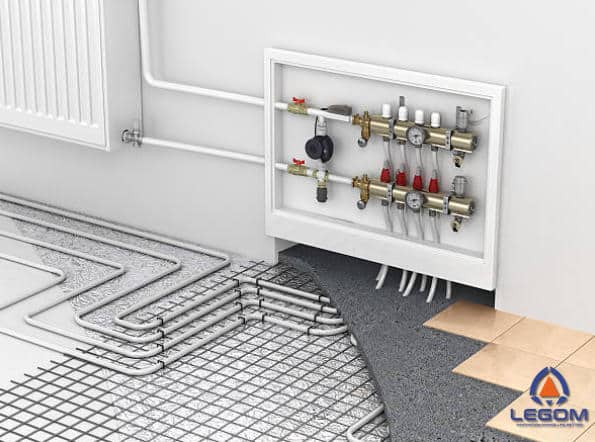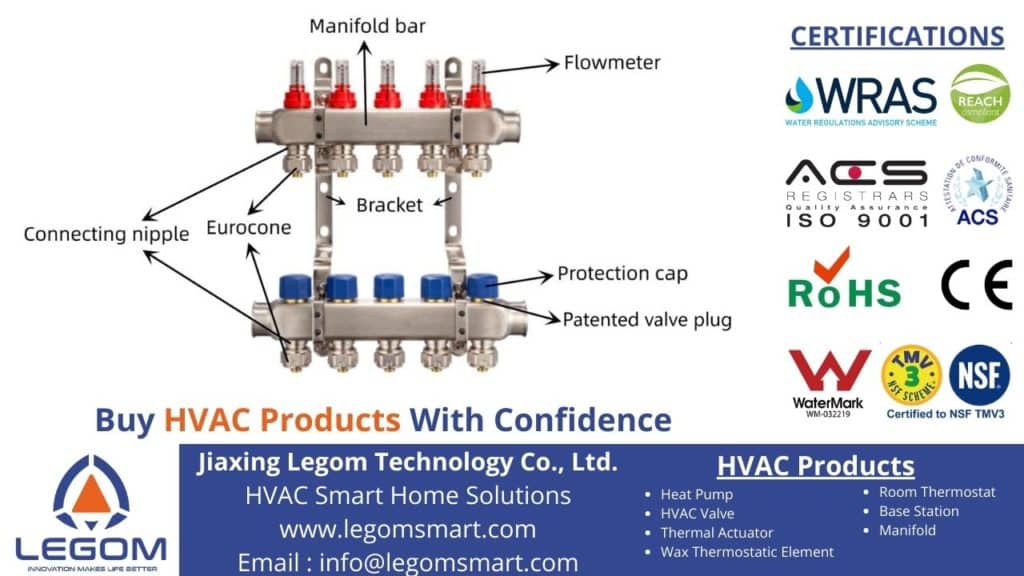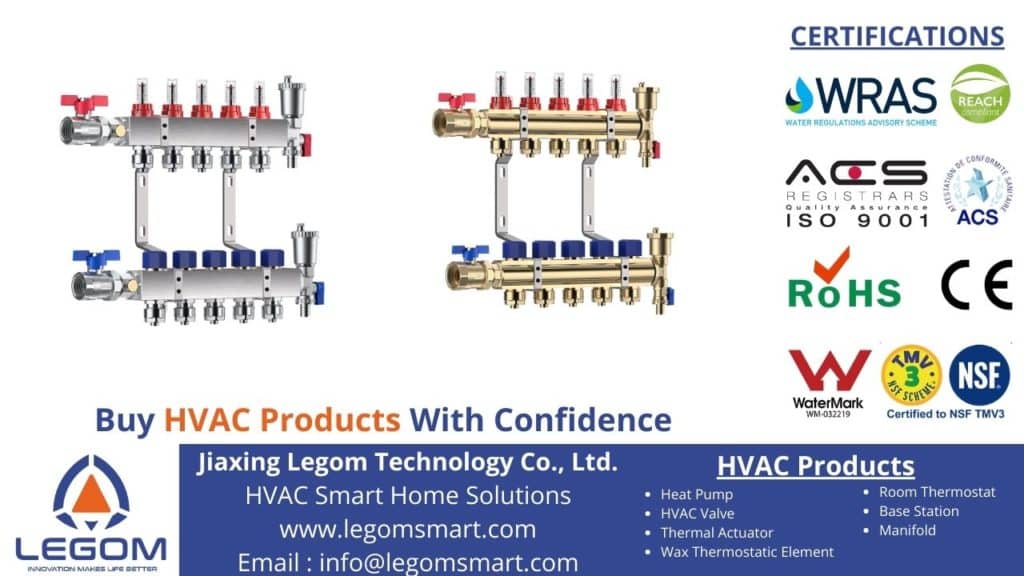
The floor heating manifold is the most important part of an underfloor water heating system. The manifold consists of pipes that technicians install beneath the floor layer to heat the space above. The use of manifolds has a major influence on the performance of the floor heating system. The manifold connects a heat source such as a boiler or heat pump with the underfloor water heating pipes.
Then the distribution of hot water slowly throughout your house will run smoothly. The manifold also regulates pressure, flow rate, and temperature settings so that you can adjust the heat on the floor. This certainly makes you and your family very comfortable.
Water supply from a heat source such as a heat pump will enter the manifold via the optional mixing unit. This will ensure the water temperature is as you wish. This is in the range of 20 to 60 Celcius degrees. You may also not need a mixing unit if the heat source provides a stable water temperature without overheating.
Meanwhile, the technician should install the underfloor heating Manifold right in the center of the heating zone for more effective performance. By doing this, a minimum pipe length can help ensure the water temperature remains constant. If your room area is very large, then you might want to use several floor heating manifolds.
Contents
The Reason Why Floor Heating Manifold is Important for Your Building?
Underfloor heating is a must for 4 season countries where the winters can be very harsh. The application of underfloor heating is quite complicated. People might imagine it as just like there is a device that pumps warm water throughout the tube and then all the rooms heat up as needed. A heating system like this needs a floor heating manifold to be able to control the flow rate and distribution of the water supply.
In every underfloor heating system, there is a water rate that passes through each tube coil. There will be heat loss in that zone which will greatly affect it. Therefore, the heating system must be balanced to ensure that the flow gets the right distribution path. Meanwhile, the fact of different tube lengths also influences the complexity of the situation more intensely.
Underfloor heating manifolds can be the solution to all the challenges that have the potential to derail heating performance. If only every building, be it a house, commercial building, or office, really pays attention to its floor heating manifold, then you can get the right temperature throughout the room safely and comfortably. The manifold ensures the correct flow of water to slide after pumping to each zone to heat it to the correct temperature. The technician who installed it also set it up correctly.
Floor Heating Manifold Components

Manifolds usually have stainless steel as their constituent material. There are also manifolds whose constituent material is brass. HVAC systems need manifolds. Likewise with the floor heating system where the manifold can distribute hot water more optimally and effectively.
You can also adjust the temperature of hot water that flows evenly as you wish. In how it works, the manifold consists of several main components with each specific function for the smooth operation of the system.
Some of the main components of floor heating manifold and their functions include:
Ball Valves
This head control valve has the function of controlling incoming and returning water. This control valve is often red to indicate water entering and blue to indicate water leaving in general installations.
Bracket
The brackets are the two main rods on the wall or back panel. Brackets can hold the manifold to the wooden frame.
Flow Meters
Flow meters can help us to see whether the water flow on pipes is constant or not. There is warm water flowing in the flow manifold where the temperature will appear on the flow temperature meter.
Manifold Bars
The manifold regulates the water flow rate through actuators. This actuator works as a temperature regulator. The actuator in this system is like a door that can open and close to allow water to flow through each circuit. Manifold bars are available in a variety of materials including stainless steel.
Protective Cap
It protects the manifold from damage during transportation and installation. Meanwhile, if the valve core is open, the protective cap can prevent problems that are likely to arise while the valve is open.
Vent Valve
The ventilation valve is at the end of the manifold which is useful in the process of releasing residual air from the system.
Connecting Nipple
The connecting nipple functions as a link between flow and return manifolds.
Eurozone
This nickel plate connects the pipework and manifolds.
Drain Valve
The drain valve can flow the whole water. Especially during the pipe cleaning and system maintenance.
Temperature Gauge
This temperature gauge allows the temperature difference between the streams to then determine the pressure and temperature in the pipe.
Valve Plugs
Valve plugs are very effective in extending manifold life. It can prevent residual scale from entering the floor heating manifold.
A Comparison of Floor Heating Manifold Materials

The two main materials in making floor heating manifolds today are brass and stainless steel. Both materials offer different advantages. You can choose based on the advantages and disadvantages.
Cost
Brass manifolds have a higher copper content and a lower zinc content. This makes the price of a brass manifold lower than a stainless steel.
Durability
Corrosion is a problem that usually occurs on metal surfaces after years of use. While wear and tear also haunts it throughout the year. Stainless steel and brass have good resistance to both. However, the durability of stainless steel manifolds is excellent for long-term use and they have a high resistance to pressure.
Environmental Impact
We can recycle brass and stainless steel. However, wastewater from both materials can have an impact on the environment. Waste from brass metal contains heavy metal ions that can cause environmental pollution. Meanwhile, stainless steel also contains elements like chromium and nickel, it is generally associated with a lower environmental impact due to its durability and corrosion resistance. Both materials require careful handling and recycling to minimize their environmental footprints
Legom Floor Heating Manifold
At Legom, we are dedicated to providing environmentally responsible and high-quality floor heating manifold solutions. We offer both brass and stainless steel manifolds, catering to diverse needs and preferences. Legom brass manifolds provide a cost-effective option with excellent heat conduction properties, while our stainless steel manifolds are prized for their superior durability and minimal environmental impact.
Both materials are recyclable, aligning with our commitment to sustainability. By choosing Legom, you can be assured of a product that not only meets your heating requirements but also contributes to a healthier environment. Invest in our floor heating manifolds for assured long-term performance and cost efficiency.
